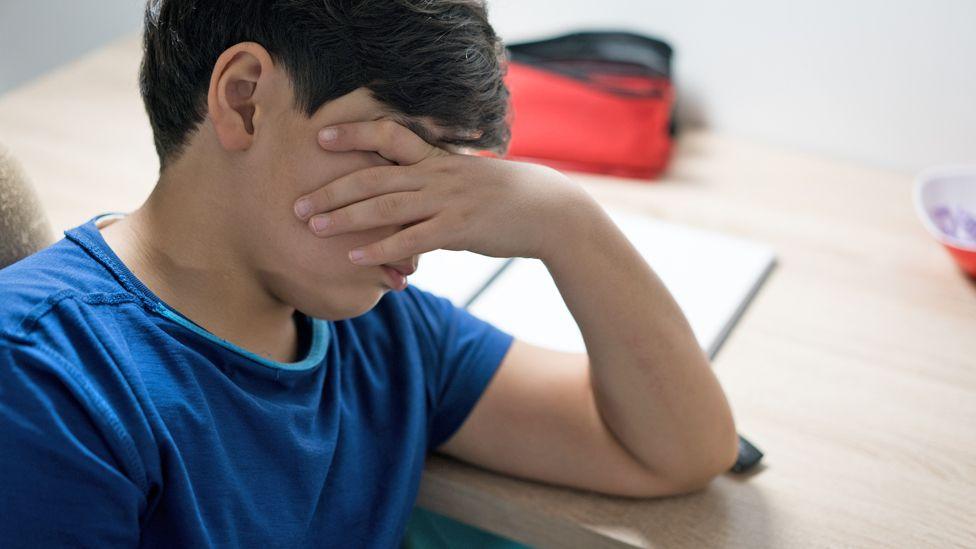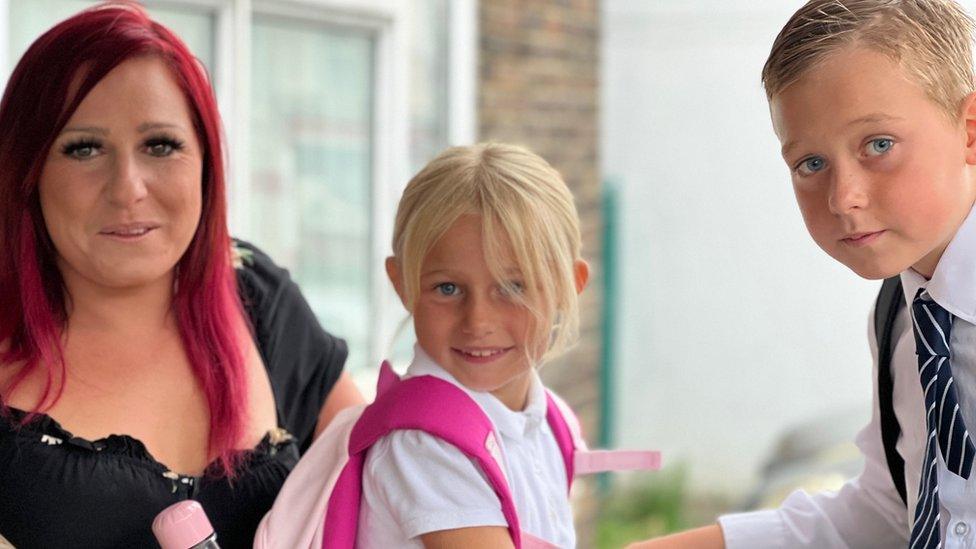Why school exclusions are at record levels

Experts say behaviour problems are often "masking an underlying unmet need"
- Published
Figures released last week showed the highest yearly numbers of suspensions and exclusions of school pupils in England. Is worsening behaviour really the only explanation?
Sara, not her real name, says she first noticed her son's irritability and difficulty socialising while at nursery during the Covid pandemic.
By the time he started school, he had complex educational needs and was showing symptoms of ADHD (attention deficit hyperactivity disorder) and autism - both of which he was later diagnosed for.
He struggled to handle the school environment, she said, resulting in meltdowns that would sometimes see him lash out in class.
"If a child had a physical disability and a wheelchair, they wouldn't tell them to mount the stairs, because they can physically see it," she says.
"But when a child has a mental health condition and they're being told they need to be quiet or stay silent, not express their emotions, it's creating a world of broken people."
Sara's son's behaviour led to a series of suspensions - banned from school temporarily.
Soon after, he was permanently excluded from school and sent to a pupil referral unit, at the age of five.
Sara says the whole experience "broke" her family.
'I thought I was just bad'
Sara's son is one of more than 9,000 children to be excluded in the 2022/23 school year.
"Persistent disruptive behaviour" was the most common reason cited for both suspensions and exclusions in that year.
Earlier this year, one in five teachers reported having been hit by a pupil in a survey commissioned by the BBC.
Simon Kidwell, former head at a primary school in Cheshire and president of the National Association of Head Teachers, says the latest data is not a simple case of poorer pupil behaviour.
Mr Kidwell believes schools struggling to cope with the soaring number of children with special educational needs and disabilities (Send) is closely linked to the rising number of exclusions - driven in part by issues recruiting and retaining teaching staff.
Teaching assistants, who he says "spend many years and develop real skills working with our most challenging children", are "leaving in droves", and specialist schools, better equipped to support pupils with complex needs, are overcrowded.
Pupil behaviour getting worse, say teachers
- Published28 March 2024
Lessons in cupboards in crowded specialist schools
- Published20 February 2023
Thousands of children waiting too long for school support, BBC finds
- Published17 May 2024
Sabrina Simpson, a lawyer at the Coram Children's Legal Centre who works with families appealing against school exclusions, says children are too often viewed through a "behaviour lens".
"I remember one child said to me, 'I thought I was just bad.' And then he found out he had ADHD," she said.
"That was really sad to hear him say he thought he was 'just naughty', because that's how everyone had made him feel."
Beth Prescott, education lead at the Centre for Social Justice, says pupils are being affected by issues from "beyond the school gates".
Exclusions "have a place" in the school system, she says, but in some cases they are "masking an underlying unmet need".
She says rising numbers of children with Send was among the "barrage of obstacles" for children to engage with their schooling - also including worsening mental health, long NHS waiting lists and the cost-of-living crisis.
Mental health problems and cost-of-living pressures on families are among the complex reasons cited for more children being persistently absent - defined as those missing at least 10% of school - than ever before.
Persistent absence rose after the pandemic, with one in five children now recorded as being absent for roughly one or more days every fortnight.
And in turn, Mr Kidwell says the high rates of persistent absence are linked to rising exclusions.
Who is being suspended and excluded?
The 790,000 suspensions and 9,400 exclusions in 2022/23 were significantly higher than any previous year, rising by 36% and 44% respectively on the year before.
The suspension rate - the number of suspensions per pupil - of nearly one in 10 is also higher than it has ever been.
Of the exclusions recorded in 2022/23:
More than half were pupils with special educational needs (who make up just 17% of the total pupil population)
Over 60% were eligible for free school meals (they form 24% of the total pupil population)
Gypsy and Roma, and Traveller of Irish heritage ethnic groups had the highest exclusion rates
There was also an over-representation of pupils from black or mixed white and black backgrounds
And there were regional disparities in the data, external too - in north-east England, pupils were four times more likely to be excluded than those in inner London, despite the areas having similar pupil populations.

Head teacher Simon Kidwell says his school only ever used suspensions as a "last resort"
Ms Simpson says she is concerned by the stark differences in exclusion rates between ethnic groups, and called for more training for schools "to address unconscious bias".
Carol Homden, head of children's charity, Coram, says the record numbers show "something is going wrong for these children".
Dr Homden, whose own son lost out on nine months of education after being excluded from school, says she wants more focus on suspensions, rather than exclusions, as they are "moments of opportunity to put a child's life back on track".
For mum Sara, the outlook for her son is now more positive after she "fought tooth and nail" to find him a place in a specialist school, from September.
But there is "still anxiety" as she wants to know for sure that the staff and new environment can help him.
"We love him for every part of him," she says.
"He doesn't deserve to be treated any differently to anybody else."
Related topics
- Published27 September 2023

- Published23 July 2024
